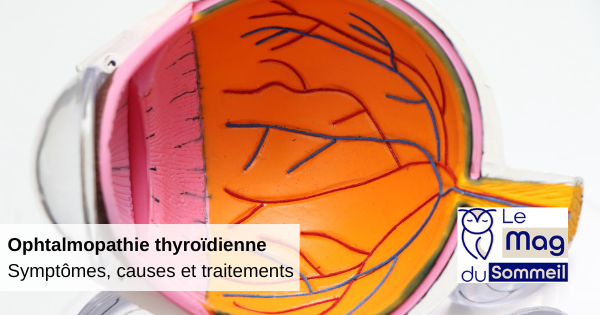Thyroid ophthalmopathy: symptoms, causes and treatments

Thyroid ophthalmopathy , also commonly known as thyroid eye disease or Graves' eye disease , is found to be an autoimmune condition. This eye disease is often related to high thyroid hormone levels, but it can also occur in hypothyroidism. Here are its symptoms, causes and how it can be treated.
Thyroid ophthalmopathy: Origins of the disease
Explanation of this ocular pathology
The thyroid is a gland located in the neck. It creates hormones that control our growth during our childhood.
But it is a gland that ensures:
- Metabolic control;
- A regulation of functions such as sleep habits, heart rate or even certain parts of sexual function.
Eye disease related to the thyroid gland usually leads to serious eye disease. Concretely, the thyroid gland produces a surplus of thyroxine, we then speak of hyperthyroidism.
The body's autoimmune response is an attack on the tissues around and behind the eyes, including the muscles that help move the eyes and the cornea.
Today, an estimated 10% of people suffer from this thyroid eye disease. Women are more affected than men: about 16 cases per 100,000 people against 2.9 cases in men. It is a disease that affects all ages, but whose peak frequency is between 40 and 50 years.
The causes and risk factors
Thyroid ophthalmopathy is mainly related to the functioning of the thyroid gland. In 8 out of 10 cases, the disease is associated with hyperthyroidism, and 10% of patients develop this pathology due to hypothyroidism. Finally, for 5% of the patients, it is noticed that there is no anomaly of the thyroid function.
Generally, this pathology occurs within 6 months after the declaration of hyperthyroidism.
The only risk factor officially recognized as negative for the development of this pathology is smoking. But we noticed other potentially suspicious factors:
- Genetic factors: HLA-DR3 genotype which is transmitted from generation to generation in 30% of patients;
- Environmental factors: tobacco and stress;
- Hormonal factors: poor control of thyroid function, hypothyroidism.
Thyroid Eye Disease Symptoms
The main symptoms of thyroid eye disease are:
- Dry eyes;
- Continuous itching of the eyes;
- swelling of the eyelids;
- Watery eyes;
- Bulging eyes in some cases;
- Double vision or misalignment of the eyes.
If the thyroid eye disease is not treated in time, it can damage the cornea or increase the pressure inside the eyes, which will damage the optic nerve and thus affect overall vision.
This disease is often observed with inflammation of the surface of the eye , including the so-called sclerotic area (the white of the eyes) or the cornea. This phase of inflammation lasts between 6 and 12 months. During these first months, there are certain signs such as photophobia , the sensation of a foreign body in the eyes or even excessive tearing.
It is then followed by a stable phase where the inflammation will reduce. The inflammatory phase, on the other hand, corresponds to the onset of hyperthyroidism. Dry eyes are caused by the eyes not being able to form enough tears. The muscles behind and around the eyes are swollen, which pushes the eyeballs forward and pulls the eyelids up.
Finally, thyroid ophthalmopathy resulting from a disorder of the thyroid gland, it is also possible to feel other associated symptoms:
- Irritability;
- Intense or chronic fatigue;
- Rapid heartbeat;
- Excessive sweating;
- Strong sensitivity to heat or cold;
- Feeling of increased anxiety.
What are the treatments for thyroid eye disease?
Usually, thyroid ophthalmopathy is diagnosed or by a general practitioner who will then refer it to an ophthalmologist. Subsequently, the patient will most likely have to consult an endocrinologist so that this professional understands in more depth the functioning of the patient's hormonal system.
In case of serious eye disease related to hyperthyroidism, several treatments are possible:
- Medication to reduce and control thyroid hormone levels;
- Radiation to shrink the thyroid gland in severe hyperthyroidism;
- Surgery to remove the thyroid gland in the most extreme cases: in this situation, the patient must take replacement thyroid hormone for the rest of their life.
Here is the main information that could possibly alarm you and allow you to refer your clients to their general practitioner.
Source: The Sleep Mag


